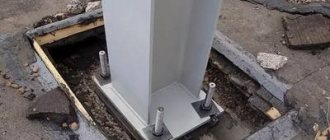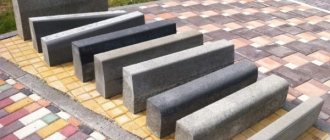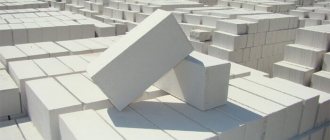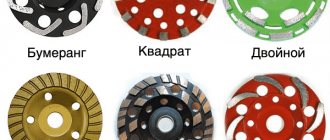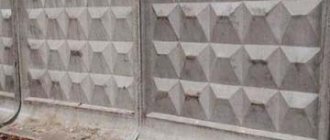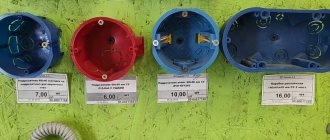Proper drainage of rain and melt water from the roofs of houses is a requirement that increases the service life of foundations and walls of buildings and structures. Therefore, a drainage system is installed under the roofs, which collects water and discharges it through vertical pipe risers. But what next, where does the discharged water go? There are two options: storm sewer and sidewalk drainage. In this article we will talk about the second one, what it is made from, what types it comes with, what are the GOST requirements for technical characteristics and dimensions, and also talk about the method of installing sidewalk drainage.
Drainage tray in a suburban area Source krasg.ru
Types of sidewalk drains
The classification of a sidewalk drainage system is based on the materials from which sidewalk drains are made. There are only three positions here:
- metal;
- plastic;
- concrete.
Metal gutters
Typically, drainage trays are made of black carbon steel. Finished products are subsequently painted or coated with other protective materials to increase the service life of the product. There are gutters made of galvanized steel on the market, which have a longer service life, as well as coating on both sides with a polymer composition.
It should be noted that the tray system made of unprotected metal is gradually losing its position. Although in many respects it is preferable to other types. Eg:
- the metal has increased strength ;
- steel trays are not as heavy as concrete products;
- if they are properly treated with protective compounds, they can last on the street for decades;
- possibility to carry out repairs directly at the installation site.
Metal gutters for open drainage Source nl.decorexpro.com
True, this type of sidewalk drainage also has its drawbacks:
- it is a noisy structure when water moves through it;
- rapid corrosion of metal under unfavorable operating conditions;
- the color scheme is poor;
- installation is carried out by installing gutters in concrete, and this is an additional cash expense .
More often on the market you can find metal drainage trays coated with polymers. They have a longer service life, plus an increased range in terms of decorative design. Of course, the corrosion-resistant characteristics are also higher.
Drainage trays with polymer coating Source noxyv.ruvegity.ru.net
Plastic variety
In general, plastic products have pushed a large number of materials and products made from different materials out of the market. Then it’s plastic:
- does not corrode under the negative influence of humidity and water;
- has a minimum specific weight , which facilitates installation and transportation;
- the material is silent;
- inert to biological and chemical activity from various materials and substances;
- low price that will surprise any consumer4
- a huge variety of colors;
- ease of installation;
- long service life .
As for the disadvantages of plastic sidewalk gutters with gratings, there are a large number of fakes that flood the modern building materials market. It is they who spoil the whole picture in terms of short service life and reduced technical characteristics. In terms of strength, such products are inferior to standard ones. So when purchasing, you must require a quality certificate.
Plastic drainage gutters with plastic gratings Source strojdvor.ru
See also: Catalog of companies that specialize in the installation of drainage and sewerage systems.
Concrete gutters
Here we must say this: this is the heaviest, but also the most durable material with a long service life. Of all the proposed options, it is also the most expensive. For comparison; the price of a plastic sidewalk drain with a grate is 1,300 rubles based on a length of 1 m, a width of 015 m, a depth of 0.2 m. A concrete one costs 1,500 rubles with the same dimensions of the tray. Please note that this price does not include the protective grille, which will have to be purchased separately.
It should also be noted that today polymer concrete gutters have appeared on the market, whose technical characteristics have been significantly increased. This is not only strength, but also service life.
Let's add to the advantages of concrete sidewalk trays6
- 100% fireproof ;
- high frost resistance ;
- 100% waterproof .
And while there are many variations in the size and cross-sectional shape of the tray, the color design leaves much to be desired. And this is the only drawback (considering the price).
Tray elements of a concrete drainage system Source m.2gis.ru
Dimensions and volumes
Information on product dimensions can be found on the label. The first letters with a number indicate the dimensions, the subsequent number indicates the vertical load. The last indicators indicate the length of the tray.
The standard length of all gutters is 1 meter , but it may be slightly longer depending on the width and weight of the product. The width of the trays can vary from 14 cm to 4 meters, the height - from 6 cm to 170 cm.
The volume of products can vary significantly, however, the most used of them are:
- L 1-7 volume 0.07 m3;
- L 2-7 volume 0.07 m3;
- L 3-8 volume 0.14 m3;
- L 300 volume 0.3 m3;
Second type of classification
There is another division of gutters according to the methods of their installation, or more precisely, according to the depth of their location. This:
- Shallow ones without gratings, which are often installed along the edges of paths, sidewalks and platforms. Their task is to remove precipitation and melting snow that flows from the surfaces of designated design elements of the territory.
- Deeply recessed , covered with gratings. The depth of installation can be different, it depends on the purpose of the storm drain. And, of course, the gratings perform purely protective functions so that no one falls into the trays.
Shallow drainage open system gutters Source dsk.od.ua
Sale of rainwater inlets made of concrete
We offer to buy concrete storm water inlets for road construction, municipal facilities and road infrastructure with the ability to choose according to the requirements of the project.
Advantages of our offer:
- a wide range of products for different design solutions;
- favorable wholesale prices for rainwater inlets of different models;
- constant availability of products in the warehouse, the possibility of delivery and pickup;
- compliance with road construction standards.
We sell concrete storm water inlets at manufacturer's prices with guarantees and documentation. To clarify information and select specifications for a storm sewer project, you can contact our specialists.
Grilles for the east
The purpose of the gratings is to protect the trays and prevent the drain from becoming clogged. And since they are located on the surface of sidewalks, blind areas and platforms, they are subject to fairly stringent requirements regarding loads. They must be durable, especially those used in alleys, parking lots and high-traffic areas. Therefore, gratings are generally made of cast iron, steel or high-strength plastic. There are also brass lattice structures on the market. But they are usually purchased by people who are not poor.
Let us add that gratings for trays are a variety of lattice parts. Here the models are in the form of square cells or round holes located across the entire surface of the element, with longitudinal and transverse slots, as well as diagonal. Manufacturers also offer openwork grilles. The photo below shows just such an option.
Openwork grating for sidewalk drainage Source ru.all.biz
What it is
Storm drain is a device that drains water from a structure. Liquid from the pipes enters a special reservoir and flows at an angle into the drainage well. The container is made from strong raw materials, so the walls do not collapse under the influence of moisture and soil pressure.
Stormwater inlets are installed next to the house. Among the tasks performed by structures, there are 3:
- Protection. Protect the foundation and blind areas from water flowing from the roof. Protect basement rooms from flooding in the spring.
- Saving. The liquid collected in the well can be used for household needs.
- Prevents blur. Prevents standing water from destroying paths, beds and flower beds.
The design of a rainwater inlet for storm drainage is very simple. There is a mesh at the top of the structure, and there is a catcher inside. Liquid enters the reservoir through the grate. The cells do not allow large debris to pass through, which could clog the system.
Features of installing sidewalk drainage
Let's start with the fact that storm sewerage is a gravity-flow system. Therefore, its elements are laid at an angle of 3-5°. The minimum slope is used if trays are used in front of the entrance to buildings. Maximum if the storm drain is laid along paths or along the perimeter of sites.
If the thickness of the drain being laid is equal to the thickness of the paving slabs, then it is mounted on the base under the slabs. If the laying is carried out deeper, then a concrete base 10-15 cm thick is placed under the trays.
If the tray drainage system is laid on the roadway, then a concrete structure is installed under the gutters with the installation of formwork.
Concrete structure for drainage trays Source remontik.org
Let's look at both options more specifically.
Option No. 1 - on a sand cushion
In principle, laying paving slabs with drainage is carried out using standard technology. That is:
- form a site for cladding by digging a trench (for a path) or a foundation pit for the site;
- lay geotextiles;
- cover it with sand 10-15 cm thick, level it and compact it;
- fill with crushed stone 10-15 cm thick with leveling;
- they install curbs around the perimeter on a concrete solution; they must be positioned horizontally;
- pour a dry mixture of sand and cement in a 1:1 ratio;
- a drainage gutter is installed along the on the laid mixture;
- then they begin to lay paving slabs , filling it with the entire area of the path or platform;
- after coating, water the finish and trays with water;
- fill the gaps between them with the same dry mixture;
- clear the last finished area;
- water again .
If alleys or areas will be subject to heavy loads, then gutters and paving slabs are laid on a cement-sand mortar with a cement-sand ratio of 1:3.
How to make a tray
Manufacturers use various technologies to create channels from cement mortar: they add polymers, fiber, and special substances to make the surface smooth. At home, you can make drainage trays by simply filling the molds with concrete mortar.
Step-by-step instruction:
- Prepare equipment for pouring. You will need molds (plastic or metal) and machine oil. Lubricate the bases thoroughly with the liquid and install the fittings in them;
- Metal wires must be secured to each other. Welding is often used for this. Please note that the metal ends should not protrude from the cement;
- After pouring, secure the forms; they must be in a certain position until the cement hardens. This is necessary to ensure maximum evenness of the surface;
- After a week, you need to carefully remove the formed channel from the pipe, if necessary, you need to cover it with a layer of paint or other coating. This will help improve the efficiency of the sewer system due to the smoothness of the walls.
Naturally, professional production differs from home production and therefore often purchased pipes have higher quality indicators. But if you follow the technology correctly, then in terms of efficiency they will practically not differ from purchased ones.
The installation schemes for concrete trays do not differ from the installation of standard metal or plastic trays. But here special attention needs to be paid to the slope of the system - experts recommend making the slope larger.
Photo - installation principle
Video: installation of concrete drainage trays
Price
The price of products depends on the technical properties of the material, ultimate capacity, size and purpose.
So, depending on weight, prices may vary:
- up to 10 kg – on average 210 rubles;
- up to 25 kg – 350 rubles;
Considering the height of the product:
- from 6 to 12.5 cm – price 190-230 rubles;
- 8-10 cm – 430-450 rubles;
- 13-16 cm – 450-470 rubles;
- over 18 cm – 490 rubles;
The cost will vary depending on the type of product and supplier.
